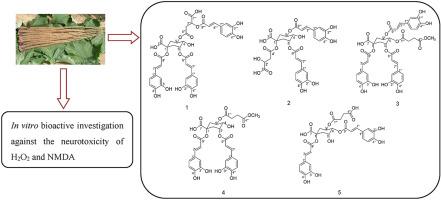当前位置:
X-MOL 学术
›
Phytochemistry
›
论文详情
Our official English website, www.x-mol.net, welcomes your
feedback! (Note: you will need to create a separate account there.)
Isolation, structure elucidation and neuroprotective effects of caffeoylquinic acid derivatives from the roots of Arctium lappa L.
Phytochemistry ( IF 3.2 ) Pub Date : 2020-09-01 , DOI: 10.1016/j.phytochem.2020.112432 Huan Gao 1 , Xiao-Wen Jiang 2 , Yue Yang 3 , Wen-Wu Liu 2 , Zi-Hua Xu 1 , Qing-Chun Zhao 1
Phytochemistry ( IF 3.2 ) Pub Date : 2020-09-01 , DOI: 10.1016/j.phytochem.2020.112432 Huan Gao 1 , Xiao-Wen Jiang 2 , Yue Yang 3 , Wen-Wu Liu 2 , Zi-Hua Xu 1 , Qing-Chun Zhao 1
Affiliation

|
Five undescribed caffeoylquinic acid derivatives (CQAs), along with fifteen known CQAs, were isolated from the roots of Arctium lappa L.(burdock). The chemical structures of compounds were determined using extensive spectroscopic analyses, including UV, IR, NMR and MS. Further in vitro bioactive investigation demonstrated the neuroprotective effects of these compounds against the neurotoxicity of hydrogen peroxide (H2O2) and N-methyl-D-aspartate (NMDA). 1,3,5-tri-O-caffeoylquinic acid and 1,4,5-tri-O-caffeoylquinic acid significantly reduced H2O2-induced human neuroblastoma SH-SY5Y cell death with concentration for 50% of maximal effect (EC50) values of 17.3 and 19.3 μM. Meanwhile, 3,5-di-O-caffeoyl-1-O-maloylquinic acid displayed protective effect against NMDA-induced cell injury with EC50 values of 18.4 μM. Overall, the more caffeoyl, the better the antioxidant activity, while the maloyl-containing compounds had better anti-NMDA activity.
中文翻译:

牛蒡根中咖啡酰奎宁酸衍生物的分离、结构解析和神经保护作用。
从牛蒡(牛蒡)的根中分离出五种未描述的咖啡酰奎宁酸衍生物 (CQA),以及 15 种已知的 CQA。化合物的化学结构是通过广泛的光谱分析确定的,包括 UV、IR、NMR 和 MS。进一步的体外生物活性研究表明,这些化合物对过氧化氢 (H2O2) 和 N-甲基-D-天冬氨酸 (NMDA) 的神经毒性具有神经保护作用。1,3,5-三-O-咖啡酰奎宁酸和 1,4,5-三-O-咖啡酰奎宁酸显着减少 H2O2 诱导的人神经母细胞瘤 SH-SY5Y 细胞死亡,浓度为最大效应 (EC50) 值的 50% 17.3 和 19.3 μM。同时,3,5-di-O-caffeoyl-1-O-maloylquinic acid 显示出对 NMDA 诱导的细胞损伤的保护作用,EC50 值为 18.4 μM。总的来说,咖啡酰越多,
更新日期:2020-09-01
中文翻译:

牛蒡根中咖啡酰奎宁酸衍生物的分离、结构解析和神经保护作用。
从牛蒡(牛蒡)的根中分离出五种未描述的咖啡酰奎宁酸衍生物 (CQA),以及 15 种已知的 CQA。化合物的化学结构是通过广泛的光谱分析确定的,包括 UV、IR、NMR 和 MS。进一步的体外生物活性研究表明,这些化合物对过氧化氢 (H2O2) 和 N-甲基-D-天冬氨酸 (NMDA) 的神经毒性具有神经保护作用。1,3,5-三-O-咖啡酰奎宁酸和 1,4,5-三-O-咖啡酰奎宁酸显着减少 H2O2 诱导的人神经母细胞瘤 SH-SY5Y 细胞死亡,浓度为最大效应 (EC50) 值的 50% 17.3 和 19.3 μM。同时,3,5-di-O-caffeoyl-1-O-maloylquinic acid 显示出对 NMDA 诱导的细胞损伤的保护作用,EC50 值为 18.4 μM。总的来说,咖啡酰越多,











































 京公网安备 11010802027423号
京公网安备 11010802027423号